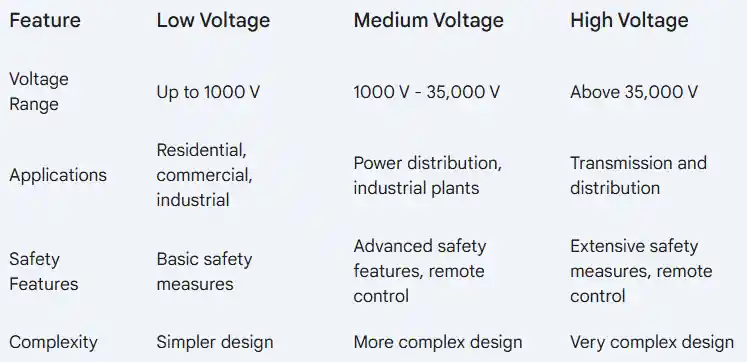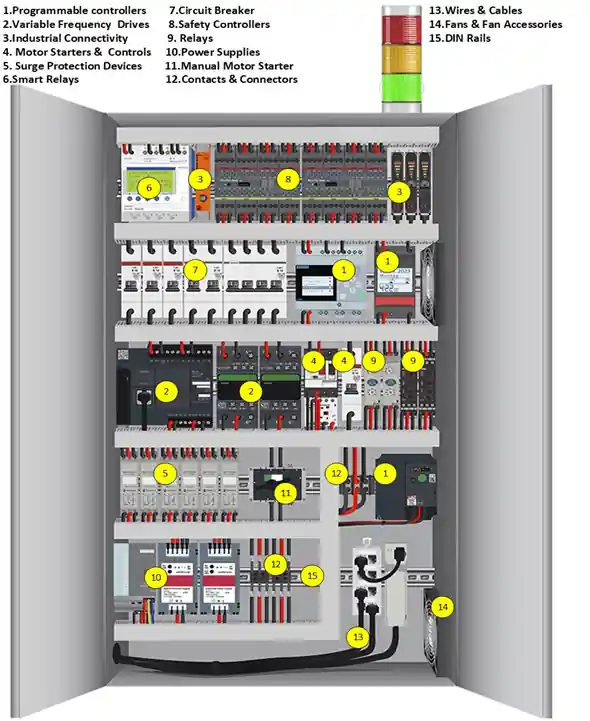Introduction
Voltage classification is a cornerstone of electrical system design and safety. Whether you’re designing a residential power system, configuring industrial automation, or sourcing components for an energy infrastructure project, understandingwhat qualifies as low voltage (LV)is essential.
In this guide, we’ll clarify the standard range forlow voltage guide, explore its applications, technical parameters, and how it differs from medium and high voltage classifications. We also provide actionable selection tips and answers to common questions—ensuring you’re well-informed and aligned with global standards.
What Does “Low Voltage” Mean?
Low voltage (LV)refers to electrical voltages that are within a defined safe limit, particularly for human interaction and low-power applications. Although definitions may vary slightly by region or regulatory body, globally accepted standards help unify these classifications.
According to theInternational Electrotechnical Commission (IEC)and many national standards, thelow voltage rangetypically includes:
- AC systems: 50V to 1000V
- DC systems: 120V to 1500V
Systems operating within this range are generally deemed safe for residential, commercial, and industrial environments when properly insulated and protected.

Common Applications of Low Voltage Systems
Low voltage power is the foundation of modern infrastructure. From consumer electronics to factory automation, LV systems serve both protective and operational roles.
Key Application Areas:
- Residential power supply: 230/400V AC systems used for lighting, outlets, and appliances
- Data centers: UPS systems and rack power distribution operate at 48V or 400V AC
- Solar power and EV: DC systems between 600V–1500V are typical for inverter and battery connections
- Commercial buildings: Elevator systems, fire alarms, and lighting circuits
- Industrial environments: Motor control centers (MCCs), switchboards, and programmable logic controllers (PLCs)

Market Relevance and Industry Trends
The low voltage sector is undergoing a technological evolution. As reported byMarketsandMarkets, theglobal low voltage electrical equipment marketis projected to reach overUSD 120 billion by 2028, with driving factors including smart buildings, electrification of transport, and renewable integration.
Innovations are focused on:
- Smart switchgearwith IoT diagnostics
- Energy-efficient LV drives
- Compact modular LV panels
- Enhancedarc flash protection
Standards likeIEC 61439-1,IEEE 1584, andNFPA 70E(National Electrical Code) continue to shape the safe design and implementation of LV systems worldwide.
Reference:IEEE Standards,Schneider Electric Whitepapers,Wikipedia – Electrical Voltage
Technical Parameters of Low Voltage Systems
While the general voltage range provides a base definition, low voltage systems differ by current, power rating, insulation class, and environmental factors.
Here’s a snapshot of standard technical attributes:
| Parameter | Typical Range |
|---|---|
| Rated Voltage (AC) | 110V, 230V, 400V, 690V, up to 1000V |
| Rated Voltage (DC) | 24V, 48V, 600V, up to 1500V |
| Frequency | 50/60Hz |
| Rated Current | 10A to 6300A |
| Short Circuit Capacity | Up to 100kA |
| Enclosure Protection | IP20 to IP65 (depending on use) |
| Standards Compliance | IEC 61439, UL 508A, ANSI C37, EN 61439 |
Comparison: Low Voltage vs Medium and High Voltage
To appreciate LV systems fully, it helps to see how they compare to medium voltage (MV) and high voltage (HV) systems:
| Category | Voltage Range | Primary Use |
|---|---|---|
| Low Voltage | ≤1000V AC / 1500V DC | Buildings, data centers, machinery |
| Medium Voltage | 1kV – 36kV | Substations, industrial distribution, motors |
| High Voltage | >36kV | Transmission lines, grid distribution |
LV systemsare cost-effective, safer to install and maintain, and require less technical specialization. Conversely,MV and HV systemsdemand advanced insulation, remote control, and stricter regulatory compliance.
Buying Advice: Choosing Low Voltage Equipment
If you’re sourcing LV systems or components, here’s what to consider:
✅ Voltage Rating
Match the equipment to your region’s standard (e.g., 400V in Europe, 480V in North America).
✅ Load Capacity
Understand the total load to select appropriate current ratings and protective devices.
✅ Fault Protection
Choose equipment with suitable short-circuit interrupt ratings and circuit isolation features.
✅ Environmental Conditions
Use IP-rated enclosures in dusty, wet, or outdoor environments.
✅ Modular vs Fixed
Modular LV switchgear and MCCs allow easier upgrades and faster installation.
✅ Compliance & Certification
Verify compliance withIEC,UL, orANSIstandards. Look for certifications from recognized testing labs likeTÜV,Intertek, orCE.

Trusted Sources and Regulatory Standards
Adherence to global and national standards ensures your LV installation is safe, efficient, and scalable. Trusted references include:
- IEC 61439-1: Low voltage switchgear and controlgear assemblies
- IEEE 1584: Arc flash hazard analysis
- NFPA 70E: Electrical safety in the workplace
- Wikipedia: Voltage Classification
- ABB and Schneider Electric Technical Guides
- IEEMA: Indian Electrical & Electronics Manufacturers’ Association
Frequently Asked Questions (FAQ)
According to IEC standards, low voltage systems go up to1000V ACand1500V DC. Above this range falls under medium voltage classification.
Low voltage systems reduce the risk of electric shock and arc flash incidents, especially when designed with proper protection (like residual current devices). They’re widely used in human-accessible environments for this reason.
Yes—many solar systemsoperate at600V to 1500V DC, which falls under the low voltage category for DC. Special attention must be paid to insulation and disconnecting means.
Conclusion
Understanding therange for low voltageis essential in power system design, whether you’re working on a commercial building, a smart home, or a renewable energy project. Generally, LV systems operate atup to 1000V AC or 1500V DC, serving as the backbone of most modern electrical infrastructure.
With increasing emphasis on energy efficiency, safety, and automation, the low voltage segment is more relevant than ever. By choosing compliant, well-specified LV equipment and staying updated with global standards, professionals can build resilient, future-ready systems.